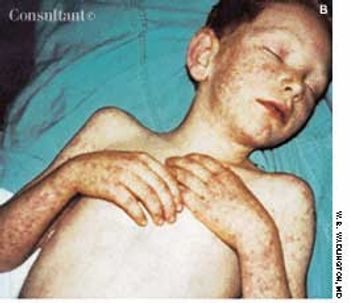
The rash of tick tularemia is seen here on the arm of a 5-year-old boy. He also had a tick bite on his back that became necrotic and ulcerated. Within 2 weeks of his having been bitten, axillary lymph nodes developed.
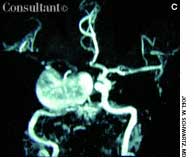

The rash of tick tularemia is seen here on the arm of a 5-year-old boy. He also had a tick bite on his back that became necrotic and ulcerated. Within 2 weeks of his having been bitten, axillary lymph nodes developed.
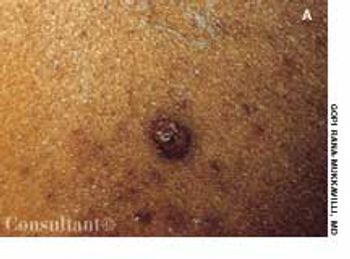
A 37-year-old man presented with fever, chills, myalgia, headache, and left-sided pleurisy of 2 weeks' duration. He also complained of weight loss and loss of appetite. The patient had recently returned from a family visit to Missouri.
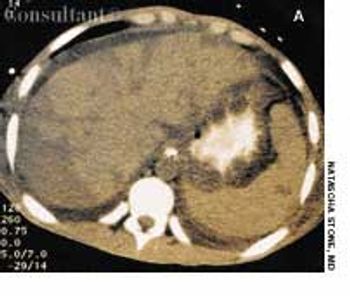
Systemic lupus erythematosus (SLE) was diagnosed in an 18-year-old man who presented with polyarthritis, fever, hypoxia, fatigue, anemia, neutropenia, and abnormal urinary sediment. A renal biopsy showed diffuse mesangial proliferative glomerulonephritis (World Health Organization class II). Serologic tests were positive for fluorescent antinuclear antibody (FANA), SS-A, SS-B, anti-Sm and anti-dsDNA antibodies, and rheumatoid factor; a direct Coombs' test result was positive as well.

An 82-year-old woman complains that for the past 6 months, she has "not felt like herself." Previously, she was very active and energetic; in fact, 9 months earlier, she had vacationed in Hawaii. It now takes all of her energy just to get out of bed.

32-year-old man presents with a 4-day history of fever (temperature as high as 38.8 C to 39.4 C with severe rigors, chills, and profuse night sweats; generalized myalgias, including dull, aching headache; and dry cough.
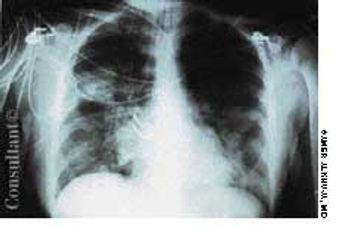
A 54-year-old woman with a history of hypertension presented with a worsening headache and a left hemisensory defect. A CT scan of her head without contrast showed a right parietal hemorrhage with spreading edema; the masslike effect caused shifting of the midline to the contralateral side. The patient gradually became comatose and required intubation for airway protection. Intravenous corticosteroids were administered to decrease the effect of the lobar hemorrhage. Fever developed 3 days after admission.

This case highlights the importance of detecting HIV infection in its earliest stages. Each year, 40,000 new cases of HIV infection are diagnosed in the United States; however, very few of these are identified at the acute infection stage. Diagnosis of primary HIV infection is important because it improves the patient's chances for a good outcome, reduces the risk of transmission, and provides epidemiologic data on virus strains in the community.

The rash of tick tularemia is seen here on the arm of a5-year-old boy. He also had a tick bite on his back that becamenecrotic and ulcerated. His axillary lymph nodesbecame palpable within 2 weeks after the tick bite.

Ruling out coronary artery disease is the first step in assessing chest pain.

The patient is a 47-year-old man who began to experiencefrequent headaches about 6 years before hepresented to a neurology clinic. The headaches rapidly progressedto become daily and almost constant. He describeda sensation of dull pressure in both temples that was presenton or within a few hours of awakening and that persistedfor the remainder of the day. He experienced a moreintense, disabling, throbbing pain in the same locationonce or twice a week, with photophobia and nausea, thatmight last 2 to 3 days. The patient took 2 to 6 over-thecounter(OTC) analgesic tablets each day-usually200 mg of ibuprofen. These would dull but not terminatethe pain.

A 30-year-old man has had painful genital lesions for the pastseveral days. He recently returned from a business trip during which hehad several unprotected sexual encounters.

Ezetimibe/simvastatin (Vytorin)recently became available for thetreatment of high LDL cholesterollevels, as adjunctive therapy to dietarymodification, in patients withprimary hypercholesterolemia ormixed hyperlipidemia. This drug,from Merck/Schering-Plough Pharmaceuticals,inhibits the productionof cholesterol in the liver and blocksthe absorption of cholesterol in theGI tract, including cholesterol obtainedfrom food.

A 23-year-old woman presents with severe right kneepain that resulted from a collision with another playerduring a soccer game. The majority of the force of theblow was to the right knee. The medical history is noncontributory.

A 48-year-old woman with a historyof hypertension and mildasthma has been transferred to themedical service because of an abnormalpostoperative ECG. She hadbeen admitted 2 weeks earlier to thegynecology-oncology service for localrecurrence of a previously resecteduterine sarcoma and underwent laparotomyfor debulking of the pelvicmass and resection of the rectosigmoidcolon. She did well until postoperativeday 14, when sudden chestpain and dyspnea developed.

A 39-year-old man complains of severe daily headaches that he describes as throbbing and "burning," with a sensationof pressure. He rates the severity of his pain as 8 to 10 on a 10-point visual analog scale (VAS) in which 10 isthe most severe. The mean duration of the headaches is 12 hours, and the mean frequency is 5 days per week. Betweenthe episodes of severe headache, he has constant "minor" headaches that are not as severe (mean severity, 3 to 5 on a10-point VAS). Within the past 5 months, he has never been totally free of headache.

For several months, a 70-year-old woman had had dysphagia,mild dyspnea on exertion, and the Raynaud phenomenon.Her skin was waxy and edematous; 2- to 10-mm pinkishspots had appeared on her fingers, palms, and oral mucousmembrane over the past 2 weeks. These disappearedcompletely with pressure. Subcutaneous calcific depositswere present on the extensor surfaces of the forearms.

In November 2002, cases of an atypical pneumonia were reported in the Guangdong province of southern China. By the following June, outbreaks of the illness-known as severe acute respiratory syndrome (SARS)-had occurred in Germany, Ireland, the United States, Canada,Hong Kong,Singapore, and Vietnam.

ain management is a commonand challenging aspect of caringfor elderly patients. The principlesthat guide therapeutic pain managementin these persons are differentfrom those used in the treatmentof younger persons.

The patient is a 56-year-old man who presents with daily headaches that occurbehind the right eye, right temple, and occasionally on the right side of theforehead. He has never experienced this type of headache on the left side. Hedescribes the pain as “stabbing,” “throbbing,” and occasionally “burning.”He rates the intensity of the pain a 7 on a 10-point visual analog scale onwhich 10 is the most severe.

ABSTRACT: Fibromyalgia syndrome (FMS) is a common condition that causes chronic pain and disability. It should be diagnosed by its own clinical characteristics of widespread musculoskeletal pain and multiple tender points. American College of Rheumatology criteria guidelines are most helpful in diagnosing FMS. The major symptoms are pain, stiffness, fatigue, poor sleep, and those of other associated conditions, for example, irritable bowel syndrome, headaches, restless legs syndrome, chronic fatigue syndrome, and depression. The pathophysiology of FMS is thought to involve central sensitization and neuroendocrine aberrations, triggered or aggravated by genetic predisposition; trauma; psychosocial distress; sleep deprivation; and peripheral nociception.
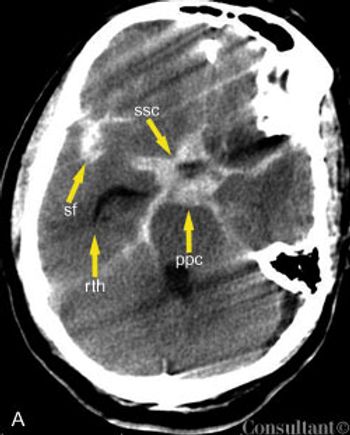
A 69-year-old man with an acute severe headache and nausea was brought to the emergency department. The patient was neurologically intact; an intracerebral hemorrhage was suspected.

The Geriatric Depression Scale is the most widelyvalidated screening tool. The questionnaire has beenreduced to a single question that is as sensitive and as specificas the 15-item shortened form of the original 30-itemscale. The question is: "How often do you feel sad or depressed?'This is certainly something that is easy to ask inthe course of a general physical examination or routine officevisit.

A 47-year-old woman who wasseropositive for HIV-1 presented tothe emergency department with severemaculopapular, erythematouseruptions. Her antiviral regimen hadrecently been changed from zidovudine, 300 mg bid; lamivudine, 150 mgbid; and saquinavir, 600 mg tid, tolamivudine, 150 mg bid; stavudine, 40mg bid; and nevirapine, 200 mg/d.

Many patients who present to the emergency department(ED) with severe headache request a narcotic to relieve thepain.

You recently diagnosed migraine without aura in a patient who complains of headaches of moderate intensity. Is a migraine-specific prescription agent warranted?